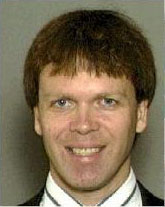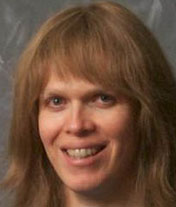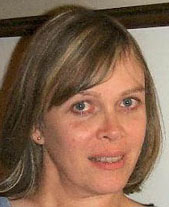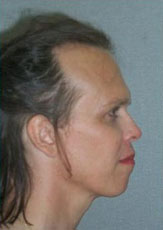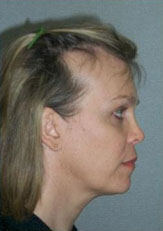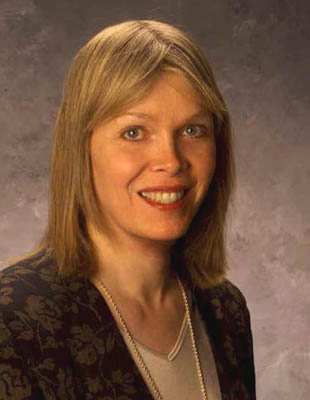-
-
- Lynn's
-
- Facial Feminization
Surgery (FFS)
-
- Copyright © 2000-2011,
Lynn Conway.
- All Rights Reserved
[version of 11-16-11]
Español
Deutsch
Français
עברית
(Hebrew)
New!
Português
Русский
(Russian) |
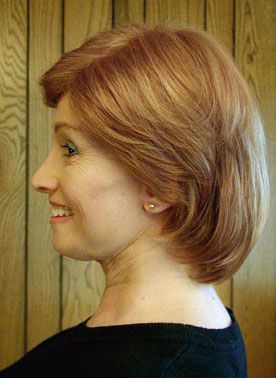 |
Post-FFS photo of Lynn: March
29, 2000
|
-
- On November 10, 1999, Lynn
Conway underwent facial feminization surgery (FFS). The 10
hour operation was performed by Douglas Ousterhout, M.D., D.D.S.,
at the Davies Campus of the California-Pacific Medical Center
in San Francisco. Doug Ousterhout is the surgeon who pioneered
this highly aggressive form of facial-bone reconstructive surgery
for transsexual women.
-
- The aim of FFS surgery is to eliminate or reduce many of
the cross-gender-related deformities of the facial bones caused
by late-pubertal testosterone masculinization in MtF transsexuals.
To visualize what's now possible, read about the surgery experiences
and take a look at the remarkable before/after photos at the
websites of Andrea
James, Becky Allison,
Gina, Madeleine,
Nicki,
Sally and
Rachel, all of whom are
patients of Dr. Ousterhout. For more links to photos
and stories about FFS, see also
Diane's page about surgery
with Dr. Ousterhout,
Jessica's page about surgery with Dr.
Spiegel at the Boston University Medical Center, and the FFS
page on the beginninglife.com website.
-
- As increasing numbers of trans women underwent these surgeries
during the early 2000's, the benefits of FFS became widely apparent -
leading to a call for wider medical availability and support for these
procedures, as by Andrea James in her
open letter
to HBIGDA of June 16, 2006:
-
- "I urge HBIGDA and all helping professionals to place a
greater emphasis on voice and face in the Standards of Care, and I
especially urge you to consider advocating for the medical necessity of
facial feminization procedures for those exposed to androgens during
puberty. . ." -
Andrea James
-
- This web-site contains background information, a diary of
events and some photographs regarding Lynn's experience in undergoing
facial feminization surgery, in hopes that this material may
be useful to others contemplating such surgery.
-
-
-
-
-
-
-
-
-
- SOME BACKGROUND
ON FFS:
-
- Back in the late 80's, Dr. Douglas Ousterhout came to understand
that facial masculinization effects in male-to-female (MtF) transsexuals
can be every bit as disfiguring and socially damaging to them
as are the effects of severe facial disfigurement in accident
victims and genetic facial deformities in children. Having extensive
maxillofacial, craniofacial, reconstructive, plastic and aesthetic
surgical experience, and a large "kit of surgical tricks"
that he could apply to solve such problems, Dr. Ousterhout began
to pioneer new methods for very aggressive surgical reconstruction
of transsexual womens' facial features.
-
- Many of the surgical techniques used to perform FFS are described
in Dr. Ousterhout's textbook Aesthetic Contouring of the Craniofacial
Skeleton, Douglas K. Ousterhout, Ed., 1991. The techniques
go well beyond traditional cosmetic surgery (as can be seen in
the drawings
and photos in that book of the surgical removal and recontouring
of a large section of forehead and eye-orbit bones to eliminate
a male-browridge).
-
- In the case of transsexual women, Dr. O. focuses on how
to adjust the dimensional parameters of each face towards the
normal female range, based on certain physical anthropological
measurements. Survival requirements over evolutionary time have
adapted human males' faces for protection in hunting and fighting,
providing them with protruding browridges and heavy jaws/chins.
However, human females' faces have evolved (as have childrens'
faces) for better hiding/fleeing by having better unobstructed
peripheral vision (with the eyes more forward in the facial structure,
and with no browridge). These differences in secondary sex characteristics
are caused by the different sex hormones present in the bodies
of boys and girls after puberty.
-
- The rapid masculinization of boys' facial features begins
during puberty and continues on into their twenties under the
influence of the male hormone testosterone, which also causes
the development of facial hair and the deepening of the voice.
Removal of the sources of testosterone (the testes) prevents
these facial masculinization effects, as can be seen in
profiles
of two Hijra on Takeshi Ishikawa's website (for many centuries
large numbers of transsexuals in India have voluntarily undergone
castration and total emasculation during their teens as part
of joining the Hijra caste; afterwards they live life as "women"
in Hijra "families"). The two Hijra in Takeshi's photo
lack prominent browridges, have small jaws and chins, and their
foreheads merge into their noseridges in smooth contours. In
the absence of testosterone, their facial features have remained
childlike and look much like those of other pretty young women
(even though Hijra don't usually have access to female hormones).
-
- But what can be done to help transsexual women who are forced
by circumstances to grow up as boys and thus must endure facial
masculinization? Surgical feminization of masculinized faces
can be done by recontouring the forehead, reducing or eliminating
the browridge, smoothly re-contouring the nose-ridge down from
the forehead, narrowing and reducing in size the jawbone and
chin (with the chin repositioned at a new angle) and reshaping
the trachea to eliminate the "Adam's apple". However,
as in reconstructive surgery for accident victims and for children
with severe cleft palates and other facial deformities, this
FFS surgery is extremely aggressive.
-
-
-
-
- One does not undergo such extreme surgical ordeals for "cosmetic
reasons". The patient must be very motivated, and willing
to take on some very real risks of pain, suffering and complications.
The FFS post-operative recovery period is painful and traumatic,
and many artifacts of the surgery linger long afterwards: bony
swelling can take months to recede, there may be numbness in
the chin area that only slowly recedes, and areas of the scalp
may lose feeling for a year or more and possibly permanently.
-
- However, in some TS cases where the browridge is very large
and the jawbone is very large, Doug's surgery can mean almost
the difference between a decent life and a living death, i.e.,
between finding easy acceptance as a normal female vs being subjected
to ongoing massive public ridicule for one's appearance. In many
of the more typical cases, the surgery replaces the TS patient's
original "tranny" features with pleasing, feminine
facial contours.
-
- For example, consider the case of
Sally,
as seen in the following three photos. The first photo (on the
left) shows her when she was still a boy, and a very handsome
boy at that. The second photo shows her after two years of hormones
and electrolysis. Many transsexual women would feel very wonderful
having made a transition from the first to the second photo,
and by contrast many might think they "look really good
now".
-
- However, although her facial features are softened and somewhat
feminine in the second photo, you'll notice that she stll has
a tranny appearance. The protruding browridge, the tall chin
and the widely flared jawbone that made her handsome as a boy
now spoil her looks as a woman. The third photo shows her after
having FFS performed by Doug Ousterhout, M.D. We now sense the
problems in the second photo, and why she "wasn't pretty"
there. The FFS transformation, while subtle, is really profound.
She is now a strikingly beautiful woman, even without any makeup
on. This is an excellent outcome. Not all results will be this
striking. However, the results are very often life-changing in
their impact on passability and self-esteem.
-
-
-
Photos of Sally:
- Pretransition; after two years
on hormones and electrolysis; after FFS with Dr. Ousterhout
-
-
-
- Well, what on earth is going on here? What has made has her
appearance change so much? The answer is seen by looking at these
same changes in PROFILE. Although we almost never look at ourselves
in profile, that is the direction from which other people often
stare at us. And it is our facial structures in profile that
most determine facial appearance and gendering at intermediate
angles towards face-on. Therefore, it is our profiles that most
frequently give-away tranny features and often keep TS women
from looking pretty.
-
- The following two photos show Sally in profile before and
after her FFS. The changing are truly astounding. Her appearance
in profile before FFS was very unflattering for a woman, even
though she looked "OK" face on. After FFS her protruding
browridge is gone, and is replaced with a rounded female contour;
her nose has been reshaped and contoured into her reshaped forehead;
her chin height and chin angle have been radically modified;
and the width and flare of her jawbone have been greatly reduced.
-
-
- Profile views of Sally before
and after FFS:
-
-
-
- It is in these PROFILE views that we clearly see the dramatice
changes made to the facial skeleton during FFS. These changes
in the underlying bony structures can undo much of the damage
done by testosterone during her first puberty. Sally finally
has facial features similar to those she might have had if she'd
gone through her initial puberty as a girl: on estrogen and without
testosterone. The final results are wonderful and are truly life-changing,
as seen in the following photo. These results also indicate how
important it is for our society to help transsexual girls earlier
in life - so they could avoid developing such masculinized facial
features which require such costly and painful surgery to correct.
-
-
-
Sally - now a beautiful woman
-
-
-
- In many ways, the innovation of FFS is having as profound
an impact on transsexual women's lives, and their chances for
happiness in life, as did the innovation of SRS. The woman who
can reverse her facial masculinization this way experiences something
much deeper than an exercise in vanity and the beautification
of appearance. Instead, these extremely aggressive surgeries
are about healing, self-acceptance, and ultimately comfort in
finding one's true place in society. For insight into this process,
see Rebecca Kastl's
essay "To
Pass or Not to Pass". And then listen to the words of
my friend Emily Hobbie:
-
-
- " When I went out before my surgery, no amount of
radiated joy and peace would have kept me from being perceived
oddly by some. I'm not talking about passing here, I'm talking
about how, as a human being, people saw me. I want people to
see *me* clearly, not through the filter of doubt about who I
might be. Even as happy and upbeat as I was prior to surgery
with Doug, the lines and curves in my face that didn't belong
to me abraded my confidence, were as wrong as a lock of hair
that stands away from your scalp that no amount of coaxing can
keep down.
-
- I am sure that if Doug's work did not exist, I would have
made the best of it, but I suspect that as much happiness as
I would have mined out of life, the difference between who I
am and who my face said I was would have eaten away at me. Who
knows.
-
- Results aside, it allows me to not simply move through
the world and society -- the best I could hope for beforehand
-- but to actively embrace it, to find a peace within myself,
or the possibility for it, that others see and perceive. It is
a wonderful resonant cycle as the relaxed comfort in my own skin
radiates from me to others, who in turn sense my centeredness
and reflect happiness back at me - - - . "
-
-
- Dr. Ousterhout's work on transsexual women has grown very
rapidly during the mid-to-late 90's as word about his remarkable
transformations spread among them and among their case counselors.
The word has spread even faster as "before-after" photos,
began to appear on TS websites, along with information on how
to prepare for and cope with this radical surgery.
Andrea
James and Nicki
Hamilton were the first TS women to post photos and accounts of their FFS experiences on the web. Their sites led Lynn and many
other trans women to visualize the FFS paradigm and decide to undergo
the surgery - leading to the posting of photos and surgery accounts by ever
increasing numbers of women. As of May 2001, Dr. Ousterhout had performed
these major facial reconstructions on about 525 to 550 transsexual
patients.
-
- Many transitioning MtF patients now undergo FFS just prior
to the social transition into their one year Real-Life Experience
(RLE). This can greatly enhance their immediate acceptance as
women during the RLE, because they look ever so much more female
in appearance than before FFS. Note that
Andrea,
Gina,
Madeleine,
Nicki,
Sally
and
Rachel
were all in early-MtF-transition when Doug did their FFS's.
-
- Better acceptance during the RLE enables many patients now
to socially transition from male to female "on the job",
helping them insure a continuity of income as they prepare to
undergo genital sex reassignment surgery (SRS) following the
RLE. Although facial feminization surgery is quite expensive,
the avoidance of loss of income can in some cases more than offset
the FFS costs. And, experience has shown that the costs of FFS
are tax deductable, since FFS is part of the overall medical
sex reassignment process and is not considered optional cosmetic
surgery.
-
- Dr. Ousterhout's offices are located in the Davies Campus
of the California-Pacific Medical Center. His address is: Douglas
Ousterhout, M.D., D.D.S., 45 Castro Street, Suite 150, San Francisco, CA
94114; telephone: (415) 626-2888;
e-mail link.
-
- If you're interested in scheduling a consultation with Dr.
Ousterhout, phone his office and ask to speak with his assistant,
Mira Coluccio. For additional background on Dr. Ousterhout and
on his surgical procedures, see URL:
http://www.drdouglasousterhout.com/
-
-
-
- WHY LYNN UNDERWENT
FFS:
-
- Lynn is a "55+" year old, post-op transsexual woman
who underwent male-to-female (MtF) sex reassignment surgery (SRS)
way back in 1968. She's fortunate to have always been fully passable
as a woman, and has had a wonderful career and life as a woman.
-
- However, Lynn has never forgotten the terrifying facial masculinization
effects that began occurring to her during her late teens, even
though those effects were fainter in her case than with many
other transsexuals. The modern FFS surgery has helped her "run
time backwards" through that horrible experience, and undo
most of those damaging physical effects. Thus for Lynn the FFS
was done to enhance her life experience and bring her some additional
psychic comfort and happiness as she grows older.
-
- Lynn's FFS surgery included hairline advancement, forehead
recontouring, browridge elimination, eyebrow repositioning, nose
reconstruction, jaw and chin reconstruction and trachea reduction,
all in one long operation known ominously as "the works"
among Dr. O's patients. The results are both subtle and amazing.
Lynn still "looks like Lynn", especially from face-on.
But there's been quite a transformation, especially when seen
in profile. Lynn now looks much more like her sister would have
appeared, had she had one.
-
- Lynn hopes the information and experiences documented here
will further help those now planning to undergo this surgery.
If you are contemplating this surgery, and have further specific
questions, you can contact Lynn by e-mail at the e-mail address
on her homepage. Lynn also hopes to keep this site as current
and useful as possible. If you have any feedback or corrections
or suggestions you'd like to make, please do contact her.
-
- For more information about Lynn, including many earlier photos,
see her homepage at: http://www.lynnconway.com,
- That site includes media articles about her life and career
at: http://ai.eecs.umich.edu/people/conway/Media/Media.html
- and also her detailed personal retrospective at:
http://ai.eecs.umich.edu/people/conway/RetrospectiveT.html
-
-
- DECISION AND
PREPARATIONS:
-
- I've always been an outdoors gal, and over the years I've
done lots of backpacking, rock climbing, running, whitewater
canoeing, motocross racing, etc. All those years out in the sun
and weather, along with natural aging, had etched quite a few
wrinkles on my face and neck. In early 1999, I began to search
for information about face-lifts and resurfacing methods to rejuvenate
my appearance.
-
- I also searched for web sites of other TS's for information
about facial surgery, and came across the amazing photos in Andrea's
James website. By looking at Andrea's and other patients' before/after
photos, especially the profiles, I began to understand just how
much the browridge/jaw/chin features affect the gender appearance
of MtF transsexuals. In an instant, I grasped the concept of
FFS and saw how far these new surgical procedures had been developed
by Dr. Ousterhout.
-
- During a trip to California in June '99, I visited Dr. Ousterhout
for a consultation to see what he might be able to do for me.
As per Mira's instructions, I'd gotten extensive facial x-rays
the day before in an X-ray lab in downtown San Francisco. Doug
then examined me and the x-rays, and we discussed all the possibilities.
I listened carefully to his initial recommendations in which
he sketched on the x-rays the recontouring that could be done
to my forehead, browridge and noseridge, and also to my jaw and
chin. When I realized how much improvement was possible, I began
thinking seriously about doing this. Upon returning home, I followed
up the consultation by contacting several previous patients by
e-mail to learn more about their experiences and results.
-
- By mid-July I'd decided that I really needed to do this.
I needed a face-lift anyways, and it was now totally clear that
it would be a huge mistake to get a face-lift without doing the
bony reconstruction first, because the benefits of a face-lift
would be nullified if I were ever to have FFS bony reductions
later-on.
-
- I've had many surgeries over the years, and it was clear
from reading other patient's descriptions that FFS would be quite
an ordeal compared to my earlier experiences. It was clearly
going to be more of an ordeal than the typical SRS. But I've
learned that as long as you are mentally prepared for pain and
trauma, and not deeply impacted psychologically by it, the bad
memories recede fairly quickly into the past afterwards. In this
case the benefits seemed to far outweigh the costs.
-
- I went back to see Dr. O in August '99 for a detailed planning
consultation. We decided that I'd get the "works",
i.e., the full set of FFS surgeries all done in one long operation.
He scheduled my surgery date for Nov 10th. I paid my deposit.
It was going to happen.
-
- Between August and October, I had a chance to personally
meet Sally
and Nicki,
two women who'd both had the "works" with Dr. O. I
was amazed at the difference the surgery had made for them, and
I learned many things from them about the surgery and recovery.
This included lots of practical tips regarding preparation, what
to take, logistics, practical things about the hospital and neighborhood,
and lots of info about what to expect during recovery.
-
- For example, based on web info and talks with Sally and Nicki
and other patients, I began to worry about claustrophobia from
spending five days with the nose-packing inside my head. I eased
my worries a little by trying a "practice run": I ate
a meal and slept one evening while wearing swimming nose-clips.
Eating and drinking were difficult; it was hard to swallow, and
my ears kept popping all the time. But I gradually got used to
it. Although it was a big nuisance, I began thinking that maybe
the nose packing wouldn't freak me out after all.
-
- As I was packing for the trip, thinking about what to take
and planning all the logistics for travel and recovery, I drew
heavily on the websites of other patients. There were many little
questions that I didn't know the answers to, and many that I
didn't know to ask. I decided to keep a diary and take the following
notes, to share with others later.
-
- [Note: Some of the photos below are rather graphic. I've
included them so that prospective patients will realize how they
might look during early recovery. Hopefully that will help reduce
the shock of patients' first "looks in the mirror"].
-
-
-
- IMPORTANT NOTE
ABOUT THE "COCOON HOUSE" RECOVERY RESIDENCE:
-
- When I underwent FFS and was released from the Davies Hospital
acute care unit (ACU) two days later, I had several options for
places to stay during the next week or so of my recovery. There
were some local motels (see below),
and also the so-called "guest rooms" in Davies hospital.
These were hospital rooms on a floor that was otherwise unused
at the time. For $60/day you could stay there and also get three
hospitals meals delivered each day.
-
- The guest rooms were convenient, and were nearby Dr. Ousterhout's
offices. However, there were some drawbacks - some patients felt
very isolated on this unused floor. Also, the hospital food didn't
appeal to some gals. In December, 2000 the guest rooms were reclaimed
by Davies, and Dr. Ousterhout's office worked out arrangements
for a new post-op residence/recovery facility now owned by two
Davies surgical nurses. Here is the e-mail sent by Mary-Lou,
one of the owners of "Cocoon House", announcing that
new facility:
-
- Lynn, Let
me introduce myself (Mary-Lou) and my partner Tricia. We are
nurses who work at the CPMC Davies campus in the operating room.
Upon hearing of the closure of the guest rooms we decided to
turn our two units into guest rooms for Dr. Ousterhouts patients.
Tricia's and my goal is to provide a non-smoking, comfortable,
safe and supportive environment. We do not provide any nursing
care!!! We are nurses who care!!! We do provide foodstuffs applicable
for patients recovering from facial feminization surgery i.e.
juices, bottled water, Jell-O, pudding, fruit cups, soups, popcicles.
Each room is equipped with tv/vcr, stereo with CD player,telephone
(local calls only), gas stove, fridge, microwave, blender, coffee
machine, hair dryer, and lock boxes for valuables. We have a
nice backyard for the guests to use complete with lemon tree!
The cocoon guest house is approximately 1 mile from the hospital.
Public transportation is very convenient (cost $1.00). The neighbourhood
(Noe Valley) is community oriented and culturally diverse. Unlike
much of san francisco our area is flat!!! Restaurants, grocery
stores and most conveniences are very close to the house.
Sincerely, Mary-Lou
-
- For about $125/day the new "Cocoon House" provides
a delightful residence, meals, and ready access to personal help
with many practical matters during recovery. This is a really
wonderful new arrangement. Contact Mira in Dr. Ousterhout's office
for more information and to make arrangements to stay at Cocoon
House before and after surgery.
-
- In the diary below, I report on my experience which included
staying in the old Davies "guest rooms". Those underging
FFS in the future should take into account the differences you'll
face when recovering in Cocoon House (or in a motel) after leaving
the ACU. For more information on that, see the Cocoon
House webpage.
LINKS TO FURTHER
FFS INFORMATION:
Since this page was first posted in
2000, ever-increasing numbers of trans women have been undergoing FFS in order
to more smoothly and successfully complete their gender transitions. As a
result, a number of prominent plastic surgeons around the world have begun doing
the type of facial surgery pioneered by Douglas Ousterhout, and are becoming
experienced in these surgeries. More and more women are
posting their stories and photos of FFS results as each year goes by, thus helping other
transitioners better
understand the cost/risk/reward tradeoffs involved in undergoing these
surgeries. All this activity has led to ever-more information about FFS being
posted on the internet. The following links will help you begin to explore all
that information:
Andrea James'
FFS information page, with links to many FFS information resources.
Beginning Life FFS page, with many
links to patients' stories and photos and to prominent FFS surgeons' websites.
Diane's page about her FFS surgery
with Dr. Ousterhout in San Francisco.
Jessica's page about
surgery with Dr. Spiegel at the Boston
University Medical Center
European TS information site: This
site provides information on FFS (and SRS) surgeons in many countries (and in
many languages).
Facial Feminization
Information.
Yahoo FFS
Support Group.
Vicki Estrada's photo-video
diary about her Facial Feminization Surgery with Dr. Spiegel in Boston
Victoria Escher's page about
her FFS with Dr. Ousterhout (including
before/after photos)
NEW
Prominent FFS surgeons' websites:
Douglas Ousterhout, M.D., San
Francisco, CA
Jeffrey Spiegel, M.D.,
Boston, MA (link to FFS page,
also see many photos at
this link)
Mark L. Zukowski, M.D.,
Chicago, IL
Frans Noorman van der
Dussen, M.D., Antwerp, Belgium
Suporn Watanyusakul, M.D.,
Chonburi, Thailand
Bart van de Ven, M.D., Ghent,
Belgium (procedures,
before/after photos,)
NEW
Marcelo Di
Maggio, M.D., Buenos Aires, Argentina (more,
more,
more,
more,
more,
more)
NEW
- ACKNOWLEDGEMENTS:
-
- Many thanks to Douglas Ousterhout for understanding and caring
about the masculinization facial disfigurement problems of transsexual
women, for applying his creative and innovative capabilities
to figure out how to solve those problems, and for applying his
unmatched surgical skills to artistically feminize the faces
of so many, many TS women.
-
- Thanks too to Doug's Office Manager and assistant
Mira
Coluccio, who
interacts closely with all patients to help them get prepared
and to ease their recovery difficulties, and who oversees Dr.
O's large medical-office enterprise to keep it running smoothly.
I also want to thank Andrea James, Sally,
Nicki,
Jessica and Carolyn for all the personal help and web-site help
they gave me as I prepared for FFS.
-
-
-
| Douglas Ousterhout, M.D.,
D.D.S. |
Doug's assistant, Mira Coluccio
|
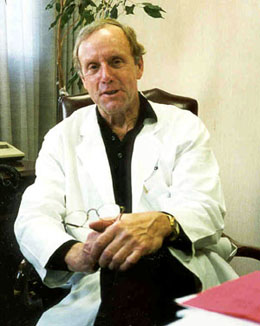 |
 |
-
-
- DIARY OF MY
FFS SURGERY AND RECOVERY:
-
- 11-8-99: I flew to San Francisco one day early to
avoid any possible problems with flight delays. Stayed one night
in the Metro Hotel (see locator maps)
near Davies Hospital. It was beautiful weather today. I enjoyed
a nice walk and scouted all the neighborhoods around the hospital
to locate the Safeway grocery store and drug stores store, the
Muni light-rail-transit stops, and various other services and
restaurants, as useful info for my boyfriend Charlie when he
arrives.Went downtown and had dinner with my friend Rom and her
partner.
-
-
- 11-9-99: Went to Davies Admitting shortly after noon,
and checked into my hospital "Guest Room" where I'll
stay tonite.Checked in with Dr. O's office at 3:00 pm for final
surgical planning, taking of the "before photos", some
lab work, paying of fees, etc. Filled some last minute prescriptions
at a nearby pharmacy on the way to dinner. Then walked over to
have dinner at Chow with Dr. O's recent patient Carolyn, who
had just had the same surgery a month ago. Got some good tips
and hints from her. Called Charlie. Went to bed early.
-
-
- 11-10-99. Surgery Day: Went down to Admitting at 6
am. Signed in and then am wheeled downstairs to prep for surgery.
I'm calm, rested and ready; I guess all those work-outs at the
Y are paying off. My last physical checkup showed BP of 110/60
and pulse of 72. Now a lot begins to happen. It's all very smoothly
efficient, and everything is kind of a blur from here on. The
IV line goes in. I remember being rolled into the operating room,
and talking with Dr. O for a little while. Then, the lights go
out.
-
- The next photo shows me after just awakening the evening
in the ACU after 10 hours on the operating table today. I have
a full face bandage on, and drain tubes are being used to drain
blood and ooze from down within the jaw/chin wound. I'm alert
and don't feel too badly. Of course I realize that this is just
a temporary respite before my body starts reacting to what has
happened to it!
-
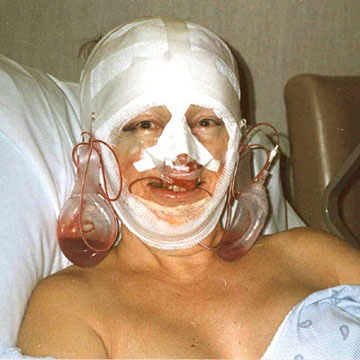
-
-
- 11-11-99: Here I am in the ACU the day after the surgery.
Dr. O has removed the full face bandages. My body has begun to
notice that something extraordinary has happened, and is reacting
accordingly. My face is very swollen now, and I've slowed down
and am settling into grinding my way through the next week or
so.
-
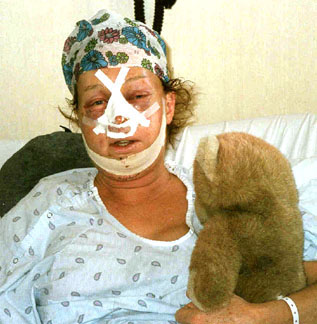
-
- This next photo is late in the afternoon of of the 11th.
My Charlie flew into SF midday, and arrived just after my full-face
bandages had been removed. I was a bit groggy here, but was I
ever so glad to see him and hug him. My face is now very swollen,
but I'm very aware that there are no major problems so far. I'm
not vomiting, my voice sort-of works, my throat isn't sore, I
can see straight and I don't feel particularly weak. Wow, I think
I got lucky - - .
-
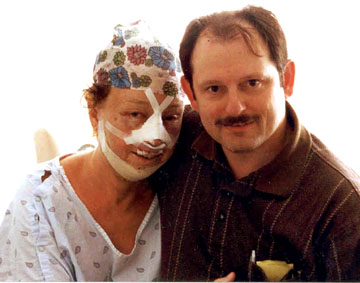
-
- Evening of the 11th. Here I am with my morphine pump
handy. It's keeping me pretty happy. Luckily I have a hearty
appetite, and the pureed food tastes great right now. I'm feeling
awake and am not in much pain now. However, I'm not totally in
contact with reality either.
-
- The facial swelling continues to increase, puffing my cheeks
way out. My hair is a soggy, bloody matted-down mess. Hmm, the
next few days are going to be interesting. Let's get some food
down while the getting's good.
-
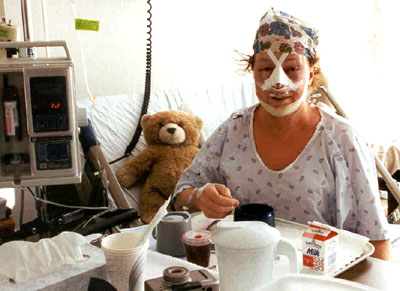
-
- I learned right away that eating was going to be a chore,
because of the nose-packing interfering with swallowing and also
the very limited amount that I could open my mouth.
-
- Then, sometime this afternoon my IV must have backed out
of its vein, because my arm started hurting. I looked at it and
saw that the forearm was all puffed up from fluid being pumped
into it. I realized what was wrong right away and called a nurse,
and she replaced the IV into my other forearm. No harm done,
but I've learned from many past surgeries that it's a good idea
to stay alert for such things, and to buzz for help right away.
-
- I'm also learning lots of wierd things, such as how wonderful
the "suction tube" is. Like the thing at the dentist's
office that sucks spit from your mouth. The problem now is huge
gooey blood clots and ooze up in behind my nose and up into my
sinuses. What makes it worse is every time you swallow anything
with the nose packing in place, some of that wants to go up in
there too! All that aggravates the psychological impact of the
darn nose packing.
-
- At first I tried to snucker that stuff down into the back
of my mouth. It was tough to do, because it was so slimy and
stuck up there. Then I accidently discovered what happened if
I stuck the suction tube back in there and caught the end of
some stuff with it. Wow, it would instantly pull a whole octopus-like
gorpy bunch of it out of there. What relief! Way cool! By the
time I left the ACU on the 12th, I'd half-filled a quart reservoir
with "stuff".
-
- Charlie stayed over at the Metro Hotel on Divisadero tonight,
the 11th. It's just a few blocks away and an easy walk to Davies.
Tomorrow when I move from the ACU into my Guest Room, Charlie
will move in with me too.
-
- The Guest Rooms are on the third floor of Davies, and although
without nursing care they are provided with hospital food services,
and are a short elevator ride and walk from Dr. O's offices.
These rooms provide comfortable, convenient, inexpensive accomodations
once ACU nursing care isn't needed.
-
- [Note: Patients (and partners) would now move to Cocoon
House, the new post-FFS recovery facility that has replaced the
Guest Rooms]
-
- 11-12/13-99: Moved from the ACU into my Guest Room
midday on the 12th. It was great to unpack a bit and get more
of my things within arms reach. What's especially wonderful is
that Charlie can now stay with me all night, sleeping in the
second bed in this room. I encouraged him to play tourist in
SF for 6 to 8 hours each day, so he'd have some fun too. But
having him return each afternoon or evening and spend the night
was wonderful.
-
- Any patient's spouse, S.O., or friend could do the same -
- you can get two keys, and the keyrings are passes through the
Davies Emergency Room area at any time, day or night.
-
- I also met JoAnne, another of Dr. O's patients today. She's
in a guest room just a couple of doors away. We were now able
to keep each other company for a while each day.
-
- The next photo shows Charlie and me in our Guest Room. The
flowers behind my head were sent by my friend Nicki. On the shelf
to the left of Charlie you'll see two "good luck" photos
that I brought with me. One is of Charlie holding one of our
cats. The other is one of my friend Sally bravely showing two
"thumbs up" while in her full-face bandage during her
surgery here.
-
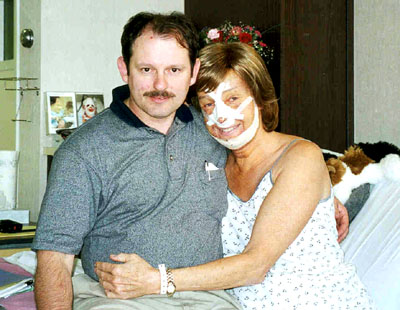
-
-
- 11-14-99: The very worst seems to be over now, and
I've settled into the grind of day-to-day coping with heavy dull
pain. Also, my nights have been pretty fitfull and I haven't
been able to sleep but for a couple of hours at a time. The bruising
on the upper face doesn't look too bad now, and the swelling
now is mainly a problem in the jaw, chin and trach areas. I've
taken on the "chipmunk" look as my friend Sally calls
it. My swollen cheeks make me look like I'm an expressionless
chipmunk with a mouthful of stuff in her cheeks - - .
-
- I've taken to walking around on the 3rd floor (the Guest
Room floor). It's 150 yards around, and is a nice, quiet relaxing
walk. You can circulate for a mile or so without seeing anyone
else, since it's almost unoccupied except for other patients
of Dr. O. You can tell how many are here by looking for food
trays outside the rooms before/after meals.
-
- I almost always left my door open, so I'd see people once
in a while. One of the food servers, undoubtedly new, once brought
my dinner into my room and said "I'm not sure what's going
on on this floor. I bring food up here and leave it outside rooms,
but never see anyone here". I said "This is the Twilight
Zone" in a very solemn voice. That seemed to reassure him
a lot.
-
- It was also very, very comforting to have a number of close
friends visiting me now. My friends Jorge and Susan visited me
yesterday; I'll be staying with them one night before flying
home on the 19th. Today Rom and her partner Luccia visited, as
did my friend Terri Wanke. I've also received lots and lots of
phone calls which, along with the visitors, have really cheered
me up.
-
- I've now begun to get into a very excited state, because
as of today I can see how amazingly this surgery is going to
affect my forehead and browridge. Along with the Vicodin pain
pills, all this has made me extremely hyperactive when on the
phone and with visitors. The nose packing and the associated
breathing and drinking difficulties are a continual nuisance,
but they didn't make me crazy or claustrophobic like I'd worried
they'd do. I'd brought a few Valiums just in case, but didn't
need to use them after all - - - .
-
- Brief description of the overall operation: Dr. Ousterhout
had made a large initial incision that accessed Lynn's forehead
and brow area. This 19 inch incision ran vertically up from the
top of each ear for about four inches, and then horizontally
circled the forward part of Lynn's scalp (the photo below shows
staples reinforcing stitches that hold together a part of this
incision). Pulling this large flap of skin downwards exposed
the forehead and browridge, part of which which Dr. Ousterhout
then sawed out and worked on outside of Lynn's head.
-
- Those forehead and browridge bones were sawed into sections,
and then reassembled with Titanium wires into a flatter form.
Dr. O then ground the surface to a smooth, convex form. After
he reshaped and resized the forehead/browridge, he wired it back
in place using Titanium wires and dissolving screws. For more
details on this unique browridge procedure, see some details
and photos from
Dr. Ousterhout's textbook.
-
- Dr. O then exploited the initial incision to advance Lynn's
hairline: He removed a section of skin and then stretched the
scalp aft of the incision forward to meet the original incision
line. Most of the incision within the hair-covered areas was
reinforced with staples after being stitched.
-
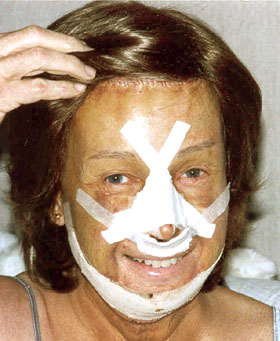
-
- In addition, Dr. O had reshaped my nose, in particular the
bone and cartilage of the nose ridge-line, so that it contoured
nicely into the new brow and forehead contours. He then made
some detailed refinements of the nose tip. In the process, he
straightened out my nose, which had been badly broken years ago
and was quite out-of-alignment left to right. In the photo above,
the nose is shown protected with internal and external splints,
internal packing and an external bandaging.
-
- The jaw and chin area is covered by a bandage compressing
the area where the jawbone has been sectioned both horizontally
and vertically. During the "double-sliding genioplasty",
pieces were taken out of the jawbone to reduce its height and
width and to change the angle of the bone underneath the chin
area. The reduced pieces were then put back together with Titanium
plates, screws and wires. Before reattachment, the jawbone was
then slid forward into a position that will yield a nice, small,
properly-positioned female chin, and then wired into place.
-
- The jaw and chin work is accomplished through a large incision
all around the base of the gums on the inside of the mouth between
the teeth and cheeks. This wound area will be quite painful for
at least two weeks after surgery, and will remain very swollen
for many more weeks after that. It's a nuisance to clean your
teeth after meals, but they have to be kept very clean to avoid
post-op infections. I'm sure glad I brought a child's tooth brush
that could easily slip down into the wound area without stretching
things too much. I think that Mira provides these toothbrushes
to most patients now.
-
- Finally, Dr. Ousterhout opened a small incision up under
my chin, through which he removed sections of tracheal cartilage
to eliminate my "adam's apple". Although mine was a
modest one and hadn't been a problem before, we knew that it
would be visibly quite obvious after my later face-lift surgery.
The trachea reduction area is also bruised and swollen in the
photo, but not too painful, yet. I didn't lose my voice during
early recovery as some have reported, although I had to keep
it rather low and soft to avoid pain from the tracheal wound
area.
-
- Even though my whole face is swollen, bruised and discolored
in the above photo, those who know me can already visualize how
much Dr. Ousterhout set my forehead back and recontoured it to
remove my browridge. Notice the higher eyebrow position, and
how much less my eyes appear to be set back into my face than
in earlier photos of me.
-
-
- Some comments on my surgical recovery so far: I was
very lucky with this surgery: I didn't step on any of the land
mines that some of the other patients have previously encountered
(extended periods of vomiting, severe sore throat from the 10
hours of intubation with a breathing tube, anxiety reaction to
the nose packing and mouth-opening restrictions, double vision
for extended periods, high-fever reaction to the surgery, loss
of voice for extended period, weight loss due to lack of appetite,
extreme tiredness for many days, etc.). Thus my appearance and
attitude returned towards normalcy fairly rapidly.
-
- However, the FFS was a major shock to my system. It was a
real grind to deal with the heavy dull pain from day to day.
You should expect major difficulties in sleeping for the first
few days, and you probably won't sleep all the night through
for the first week to ten days. My bowel movements stopped for
three days (effects of surgery and antibiotics). I'd worried
about constipation, but on the fourth day post-op I had a large
full movement without trouble (probably thanks to taking Metamucil
in some water at my morning meals each day, and a couple of Ex-Lax's
on the 3rd and 4th days).
-
- The basic activities surrounding eating are made quite difficult
due to the effects of the nose packing, the pain and swelling
in your lower gums, and the very limited amount you can open
your mouth ( I could just barely fit my thumb's smaller dimension
between my upper and lower teeth).
-
- For the first four or five days, you'll probably really need
to take a Vicodin pill once every four to six hours. You'll know
when you need to take one. After that, I reduced the dosage to
a half-tablet every six hours and then tailed that dosage off
as the days went by.
-
- Anyone contemplating this serious surgery should prepare
very thoroughly and get in good shape physically. By learning
what to expect day to day from web sites and discussions with
previous patients, one can take things to help cope with possible
problems, and one can also avoid becoming unnecessarily frightened
by and anxious about the ongoing wierd things that occur during
recovery. Visitors and phone calls are good distractions from
the daily grind while in the hospital.
-
-
- 11-15-99: Still spent a very fitfull night. Woke up
in pain, and took a Vicodin. Then got some more sleep. Felt OK
by breakfast. Sort of tired and dazed, but not too bad either.
Stomach a bit upset by a too-full feeling, since still not eliminating
quite enough to keep up with intake.
-
- Finally washed my hair for the first time this morning. Did
this by sitting and leaning back at the sink, using lots of towels,
and care not to get any of the facial bandages wet. Took a long
time even for a crude shampooing to get most of the blood and
goop out, but I felt ever so much better afterwards.
-
- Mira called and said to come to Dr. O's offices at 4pm for
first bandage/stitch removals. Charlie came with me (and watched)
as Mira removed the nose-packing, some of the inside nose stitches,
some of the trachea stiches, and the jaw/chin bandage. Dr. O
came by and he removed my forehead stiches. I'd worried about
pain from some of these procedures, but all were done very quickly
and with only minor, quite tolerable pain. I must say though
that the packing removal procedure was scary, as length after
length kept coming out. I kept wondering when it would end, and
if there would be pain somewhere along the way - - . It turned
out that the anticipation about these procedures, especially
about the removal of the nose-packing removal, was worse than
the reality.
-
- I was feeling well enough by now that Charlie and I decided
to get out of the hospital for a while. We walked from Davies
down to the N-Line Muni light-rail stop just a block away from
the hospital, and took the Muni downtown to the Powell Street
Station. We explored the San
Francisco Shopping Centre, which you can enter from that
Muni subway station without going outside. It's a neat place
to shop, and you can get there from Davies via the N-Line with
little walking or exposure to the weather (or from Cocoon House
via the J-Line).
-
- We also walked around for a while in the Market Street and
Union Square area, and browsed in some of the department stores
there. I reminisced about the time 31-33 years ago during my
transition when I drove up the Peninsula from Palo Alto each
week to undergo long electrolysis sessions in an office just
off Union Square.
-
- We took the L-line Muni subway back towards Davies, and got
off at Market and Church near the Safeway store. We bought a
bunch of deli goodies at Safeway, and walked back to our room
for a nice evening meal. I had to squash my sandwiches down flat
so that I could fit them into the side of my mouth. But it was
great to be able to eat with the darn nose-packing out!
-
- Slept better that night. Went to bed at 10pm; woke once at
12:30 to go pee; then slept all the way thru to 6:30am the next
morning. Ah that felt nice!
-
-
- 11-16-99:
-
- Felt better after the good nite's rest. Charlie packed, and
we talked a lot. He had to get back to Michigan and his work.
Went down to the lobby at 10am. His "Super-Shuttle"
arrived right on time at 10:30 to get him to the airport plenty
early for his 12:50 flight. I was sad to see him go; he'd been
wonderful through all this, and it had been quite an ordeal for
him too - - .
-
- I got a nice sandwich and some fruit at the corner mart near
Davies. Also checked out the cafeteria down on "B"
level of the hospital, and started bringing tasty items up from
there too, helping to improve my appetite again, which had finally
languished after 5 days on the hospital food.
-
- The rest of that day I spent lots of time on the phone with
friends - - and I called Charlie that eve when he got home -
- our three kitties had been lonely for us, so he gave them hugs
for me too - - .
-
-
- 11-17-99:
-
- Awoke early. Started organizing my stuff a bit, since I'll
be leaving tomorrow. About 9am, Dr. O called and asked if I could
come down early today to have him remove my nose splints (a day
early). I took a Vicodin and went down to his offices.
-
- Dr. O first removed the remaining "X" nose bandages,
and it was then time to remove the internal plastic "splints"
from way back inside of each nostril. I was quite apprehensive,
since I'd read that others had experienced great pain during
this procedure. However, although it seemed like he was pulling
large "bones" from deep inside my face out through
my nose, it didn't hurt all that much. As with the packing, the
anticipation was worse than the event. However, I was sure glad
to get that over with - - - .
-
- Dr. O then handed me a mirror, and I got my first look at
my new face. Albeit with a lot of swelling and bruising still
remaining, I was amazed at how much improvement was already visible.
The new noseridge contoured very gracefully down from the new
female browline to create a wonderful new impression. We chatted
for a while, and he carefully went over various aftercare information:
wash face with fingers (no washcloth) for a while, since the
nose is numb and you want to put even pressure of each side while
the cartilage is still soft; NO EYEGLASSES for six weeks, until
the nose cartilage firms up; no activities that would raise blood
pressure for another two weeks, after which I can resume normal
exercising; no wearing of hats that would put pressure on the
forehead bones for six weeks (bony softness must firm up first);
etc. With all the bandages finally off, I was OK'ed to take a
full shower that day (although the hospital showers are so strong
that I was still very careful not to have it directly spray on
my face and head).
-
- That evening I got really cleaned up and dressed nicely for
the first time since the operation. I put on a skirt and sweater
instead of the khaki's I'd been living in the past week. By now,
my normal make-up covered most of the bruising, and made me look
and feel better too. My friends Dick and Peggy came to visit
me, and we walked over to the Thai House, a few blocks away on
Noe Street for a great Thai dinner and a wonderful evening of
conversation. I was still very swollen and in some pain, but
it was really nice to get out to dinner with my good friends.
-
-
- 11-18-99:
-
- This morning I packed, and then went to Dr. O's offices to
have Mira remove the staples from my scalp, and to have her take
some initial "after" photos. We went over some planning
and logistics for my next trip out for the face-lift on 2-24-00.
-
- Left Davies at 11am; my friend Jorge picked me up; I'll stay
with Jorge and his wife Susan down in San Carlos tonite, and
they'll drive me to the airport tomorrow for my flight home.
-
-
- 11-19-99:
-
- After a nice evening and meal and a good night's sleep at
my friends' place, they drove me to the airport for my flight
home. It was great to get back to Michigan, and see Charlie at
the arrival gate at the airport. The trip was tiring, and I was
so glad to get home, see our kitties again, and to be able to
sleep in our own bed there. Before going to bed I weighed myself.
Amazingly, I still weighed 155#, which was my set-point prior
to deliberately gaining 5# during the two weeks before surgery.
I'd thought that I might lose more weight as, others have reported.
But that didn't happen. Now I need to work a bit to take my set-point
down to 150# , where I've wanted it to be before (and long-term
after) the face-lift surgery in February.
-
-
- 11-24-99 (2 weeks post-op)
-
- My first week home I took it very easy. I was still very
swollen in the jaw/chin area, and in some pain. I also tired
very easily. So it was a time to just relax, eat well, and get
a lot of sleep.
-
-
- 12-1-99 (3 weeks post-op)
-
- Although the swelling hadn't really gone down much, I felt
much better this week. By late in the week I resumed light work
activity, and also resumed moderate workouts at our local Y every
few days.
-
-
- 12-8-99 (4-weeks post-op)
-
- Although everything was healing well, and I was set to return
to normal activities, I hit a problem this week. On Dec. 6th
a small lump appeared at the lower right corner of my chin. By
the 7th it was quite swollen. I called Mira, and Dr. O prescribed
CIPRO.
-
- This localized infection wasn't under control by the10th,
and my face looked a little wierd due to the swollen lump under
the right side of my chin. On the 11th Doug prescribed Augmentin,
a different antibiotic. About 48 hours later the infection eased
and the swelling began to go down. Then late that day, it came
right back again! Doug reassured me that at the worst the local
infection might need to be drained to help the antibiotics work,
and that this minor procedure could be done in Ann Arbor, by
a plastic surgeon at UM Hospital who is a friend and colleague
of his.
-
- The swelling, pain and appearance effects messed up this
week for me. I mostly hunkered-down and stayed at home. So, do
not count on being "fully effective" even this long
after such major surgery. Minor complications can happen. Don't
get your activities too tightly scheduled. Be prepared to deal
with contingencies.
-
-
- 12-15-99 (5-weeks post-op)
-
- During the next week I continued on the Augmentin. Late this
week the swelling eased. Dr. O prescribed some more Augmentin
for me to take for another week, to be completely sure of clearing
the infection.
-
-
- 12-22-99 (6-weeks post-op)
-
- All signs of infection went away this week. I went off the
Augmentin mid-week and finally began to resume all normal activities.
The bony swelling in the jaw and chin is now down quite a bit,
although it is irregular and lumpy in places. Almost all the
bony pain is gone now. My chin was still quite numb, but my lower
lip was more sensitive again so that I didn't "drool"
as much when I eat. I still couldn't open my mouth very wide
(only 20mm), so eating still involved cutting things into small
pieces and inserting things into the side of my mouth.
-
- My appearance when made up, happy and smiling was very nicely
feminine now. Even given the limitations due to healing and recovery,
and how funny and sore my face felt to me, many people at gatherings
felt compelled to comment on "how well I look!" Folks
clearly noticed nice changes, but weren't able to interpret them
and figure out what happened. They're thinking maybe I've lost
weight since they saw me last? Or perhaps I've been doing a lot
of exercising? I also caught glimpses of acquaintances staring
at me in profile in a state of slight confusion. They were probably
trying to figure out why their recollections were so far off-base.
It was fun to experience these reactions, which helped to keep
the smile on too!
-
- 12-29-99 (7 weeks post-op)
-
- The jaw and chin swelling dropped off rapidly this week.
There were still a few random bumps of swelling left, but I'm
finally seeing what the jaw and chin will eventually look like.
It's wonderful! I couldn't be more pleased. The reduction is
far more than I'd originally thought could be done, and the appearance
of the chin is really very cute. Also, the banding and swelling
from the tracheal wound went down a lot, and I could now also
see how much Doug reduced my tracheal "bump". It's
gone completely, and there will be nothing but a nice smooth
neck contour showing once the face-lift is done. Wow, I ever
so thrilled with the results now! I should post some photo updates
sometime soon - - .
-
- 1-10-00 (2 months post-op)
-
- Back to near normalcy now. There is still some lingering
jaw swelling and numbness in my chin and left cheek, and some
"banding" in my neck tissues where the trach incision
was made. The swelling is down enough now to get me worrying
again about needing the face-lift.
-
- 2-10-00 (3 months post-op)
-
- Almost time to go back to Davies for the face lift on Feb.
24th. And it's a good thing: As the FFS swelling went down further,
the need for a face-lift became ever more obvious. A lot of new
wrinkles and sags are showing now, unless I keep a big smile
on my face!
-
- On the other hand, I'm finally able to open my mouth much
wider ( 30mm ), and can thus eat things more normally, including
eating sandwiches without flattening them first!
-
-
-
- LYNN'S INITIAL
FFS SURGICAL RESULTS:
-
- This section provides some photos of and comments on the
results of my FFS surgery as the results become increasingly
evident during longer-term recovery.
-
- First we'll see some initial "after photos" taken
of me on Nov. 26th, when just 2-weeks and 2-days post-op. It's
amazing how fast I'd been healing just the prior few days. I'm
still quite weakened at this point, and have to take it easy.
But, almost all bruising and discoloration have disappeared over
the last couple of days. What's left can be easily covered by
regular make-up.
-
- Of course, there is still very heavy, hard swelling underneath
the jaw and chin, which shows up as large lumps in the following
photos. There is still quite a bit of numbness in the lower lip,
lower jaw and chin, and also in the forehead and brow area. As
the numbness gradually recedes it is replaced by dull heavy pain
and a wierd tinglyness as the nerves begin to recover their functions.
As of this point, I can't yet control my lower lip movements
or my chin's facial muscles, making the effects of the swelling
much more noticeable in person than in photos.
-
- However, I am thrilled at the results we're seeing, even
now at this very early stage with LOTS of swelling and pain remaining
(mainly in the jaw/chin area). My friends will immediately see
the huge difference in my appearance in profile. I've never ever
shown photos of me before in profile, or even front-on photos
without my hair down over my forehead. The elimination of my
old browridge, recontouring of forehead and nose-ridge, and reduction
in size and narrowing of the chin changes all that.
-
- I can't wait to see how it's all going to look when the jaw
and chin swelling goes down completely. Dr. Ousterhout really
performs miracles with his FFS surgeries. Time will tell, but
I think he's done it again - - for me.
-
|
Nov. 26, 1999: Lynn at 16
days post-FFS (still with LOTS of
jaw/chin swelling) |
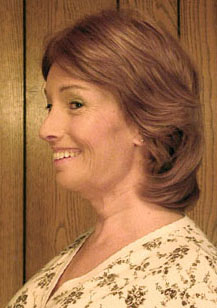
|
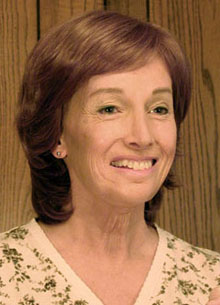 |
-
-
- Also, I noticed a very interesting side-effect of the noseridge
and browridge reduction: My peripheral vision has been greatly
extended up, to the sides, and (in binocular vision) across the
nose, because those bony areas are no longer blocking so much
of the view. It's like shifting from an older car into a newer
one that has a much wider, higher windshield.
-
- As an update, here are some snapshots, including one of Charlie
and me at Christmas dinner while visiting with my brother and
his wife in Wisconsin, and another taken in San Francisco in
February. Even though these photos are limited in resolution,
my new facial contours are quite noticeable in the semi-profile
views taken at 6-1/2 weeks post-op and 3-1/2 months postop:
-
|
Charlie and Lynn, December
25, 1999 |
February 22, 2000 |
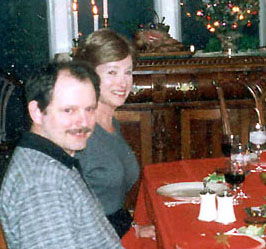
|
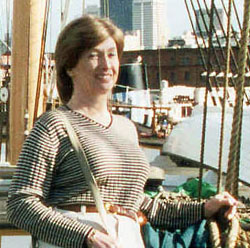
|
-
- Of course, there's still some more to do to complete my FFS
project. It takes several months for the bony swelling to shrink
back to where it's not noticeable. With that shrinkage, all the
bone removal means that I must get a face lift, because at my
age my skin will not shrink back all the way as the swelling
goes away. You can see the loose skin down in the front of my
neck and around my eyes in the detailed 2 weeks + 2 days "after
photos" above. For a while, in late January and February
of '00, I'll actually look lots older because of all that loosened
skin. However, that problem will be solved by Dr. Ousterhout
on Feb. 24, 2000, when he works on me for another 6 hours on
the operating table to do my face-lift and some skin-tightening
around my eyes.
-
-
-
- LYNN'S FACE-LIFT
SURGERY (FLS) DIARY:
-
- In many older patients, face-lift surgery may be necessary
as a follow-up to FFS. Some patients may have already needed
a face-lift prior to FFS, and/or their facial skin may not adequately
shrink and tighten up after the FFS's reduction of facial skeletal
dimensions. In such patients, a face-lift can produce dramatic
overall results, making them not only look more feminine, but
much younger too.
-
- Dr. Ousterhout requires a wait of at least a 3 months after
FFS before doing the face-lift surgery, in order to insure adequate
reduction in bony swelling after FFS. During the final month
or so of that wait, you will not look your best due to all the
wrinkles and sags. By then you'll be highly motivated to get
on with the face-lift!
-
- On February 24, 2000, Lynn underwent face-lift surgery and
blepheroplasty (upper and lower eyelid surgery) by Dr. Ousterhout
at Davies Hospital in San Francisco. For a detailed diary regarding
this surgery, including photos and tips and hints, see the following
subpage:
-
-
-
- The physical impact of face-lift surgery was far less severe
than was FFS. Readers can see the difference for themselves by
comparing the photos of me during early recovery at that face-lift
site, with those of me during early FFS recovery. The first four
days or so after FFS were quite an ordeal. The photos taken during
early FFS recovery show me in great pain, with an extremely swollen
face, grimly hanging on and sweating-out the passage of time.
In contrast, the photos at the Face Lift page show me bouncing
back pretty quickly during early recovery. While there was pain,
bruising and swelling after the face-lift surgery, it was quite
tolerable and nothing in comparison with trauma of the initial
FFS.
-
|
Here we go again! Lynn shortly
after face-lift surgery, February 24, 2000 |
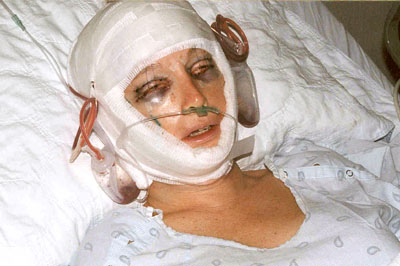
|
-
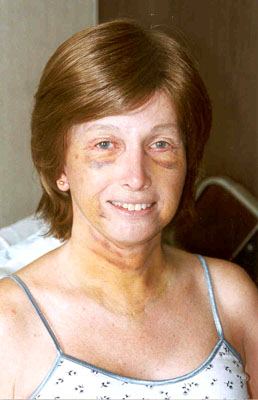
|
Five days after her face-lift
surgery, Lynn is feeling just fine.
February 29, 2000 |
-
- The face-lift and eye-lid surgery put the "frosting
on the cake", and a few weeks later the amazing overall
results of the FFS and FLS surgeries were finally revealed.
-
-
-
- LYNN'S OVERALL
FFS/FLS SURGICAL RESULTS:
-
- Following are digital camera snapshots of my FFS/FLS results,
taken March 29, 2000. My facial skin is still very tight, and
there's still some minor bruising and some swelling remaining
in my cheeks at 5 weeks postop from the face-lift surgery. Although
I'm having a little trouble smiling and making facial expressions,
the overall results of the surgeries are now becoming clear.
-
- I'm very thrilled with these results, which not only make
me look very female but also much younger than my actual age.
The effect of FFS on feminizing my profile seems almost unbelieveable
to me. Then the face lift removed the jowls in my cheeks and
large wrinkles in my face, and also the "turkey neck"
folds of skin under my chin. The blepheroplasty removed the large
bags of skin over and under my eyes. I'll probably undergo laser
resurfacing to reduce the finer facial wrinkles too, but that
will wait for another year or so. Doug has worked his miracle
for me, and it's truly wonderful!
-
- March 29, 2000: Lynn at 4-1/2 months post-op from FFS, and
5 weeks postop from face-lift surgery
- [Lynn's skin is very tight, and she's
having trouble smiling, but the results
look great already]
|
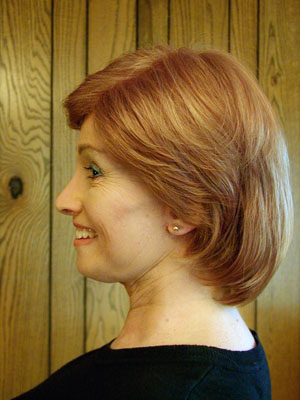 |
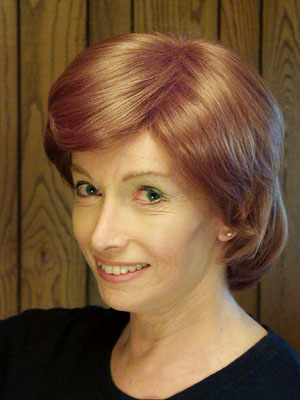 |
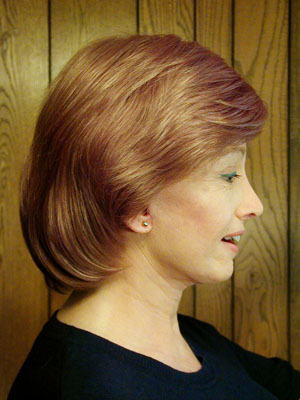 |
-
-
- Following is a photo taken two months later, on May 29, 2000.
My skin isn't so tight now, and I've been getting used to how
my new face "works". I've been exercising my facial
muscles a lot, and I can make more relaxed, natural smiles and
a normal range of nice facial expressions again. Now the result
looks really wonderful to me!
-
-

